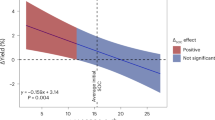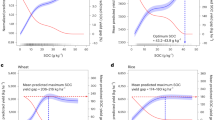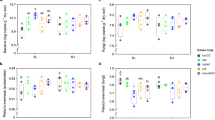Abstract
In agricultural systems, optimization of carbon and nitrogen cycling through soil organic matter can improve soil fertility and yields while reducing negative environmental impact. A basic tenet that has guided the management of soil organic matter for decades has been that equilibrium levels of carbon and nitrogen are controlled by their net input and that qualitative differences in these inputs are relatively unimportant1,2,3. This contrasts with natural ecosystems in which there are significant effects of species composition and litter quality on carbon and nitrogen cycling4,5. Here we report the net balances of carbon and nitrogen from a 15-year study in which three distinct maize/soybean agroecosystems are compared. Quantitative differences in net primary productivity and nitrogen balance across agroecosystems do not account for the observed changes in soil carbon and nitrogen. We suggest that the use of low carbon-to-nitrogen organic residues to maintain soil fertility, combined with greater temporal diversity in cropping sequences, significantly increases the retention of soil carbon and nitrogen, which has important implications for regional and global carbon and nitrogen budgets, sustained production, and environmental quality.
This is a preview of subscription content, access via your institution
Access options
Subscribe to this journal
Receive 51 print issues and online access
$199.00 per year
only $3.90 per issue
Buy this article
- Purchase on Springer Link
- Instant access to full article PDF
Prices may be subject to local taxes which are calculated during checkout



Similar content being viewed by others
References
Larson, W. E., Clapp, C. E., Pierre, W. H. & Morachan, Y. B. Effects of increasing amounts of organic residues on continuous corn: II. Organic carbon, nitrogen, phosphorus, and sulfur. Agron. J. 64, 204–208 (1972).
Rasmussen, P. E., Allmaras, R. R., Rohde, C. R. & Roagers, N. C. J Crop residue influences on soil carbon and nitrogen in a wheat-fallow system. Soil Sci. Soc. Am. J. 44, 596–600 (1980).
Havlin, J. L., Kissel, D. E., Maddux, L. D., Claassen, M. M. & Long, J. H. Crop rotation and tillage effects on soil organic carbon and nitrogen. Soil Sci. Soc. Am. J. 54, 448–452 (1990).
Hobbie, S. Effects of plant species on nutrient cycling. TREE 7, 336–339 (1992).
Wedin, D. A. & Tilman, D. Species effects on nitrogen cycling: a test with perennial grasses. Oceologia 84, 433–441 (1990).
Drinkwater, L. E., Workneh, F., Letourneau, D. K., van Bruggen, A. H. C. & Shennan, C. Fundamental differences in organic and conventional tomato agroecosystems in California. Ecol. Appl. 5, 1098–112 (1995).
Hanson, J. C., Lichtenberg, E. & Peters, S. E. Organic versus conventional grain production in the mid-Atlantic: an economic and farming system overview. J. Alt. Agric. 12, 2–9 (1996).
Paustian, K., Parton, W. J. & Persson, J. Modeling soil organic matter in organic-amended and nitrogen-fertilized long-term plots. Soil Sci. Soc. Am J. 56, 476–488 (1992).
Hassink, J. Density fractions of soil macroorganic matter and microbial biomass as predictors of C andN mineralization. Soil Biol. Biochem. 27, 1099–1108 (1992).
Gregorich, E. G., Ellert, B. H., Drury, C. F. & Liang, B. C. Fertilization effects on soil organic matter turnover and corn residue C storage. Soil Sci. Soc. Am. J. 60, 472–476 (1996).
Schlesinger, W. H. Biogeochemistry: An Analysis of Global Change 108–140 (Academic, San Diego, 1991).
Zak, D. R. & Pregitzer, K. S. in Successes, Limitations and Frontiers in Ecosystem Science (eds Pace, M. L. & Groffman, P. M.) 372–403 (Springer, New York, 1998).
Angers, D. A. & Mehuys, G. R. Effects of cropping on macro-aggregation of a marine-clay soil. Can. J. Soil Sci. 69, 373–380 (1989).
Holland, E. A. & Coleman, D. C. Litter placement effects on microbial and organic matter dynamics in an agroecosystem. Ecology 68, 425–433 (1987).
Kassim, G., Martin, J. P. & Haider, K. Incorporation of a wide variety of organic substrate carbons into soil biomass as estimated by the fumigation procedure. Soil Sci. Soc. Am. J. 45, 1106–1112 (1981).
LaRue, T. A. & Patterson, T. G. How much nitrogen do legumes fix? Adv. Agron. 34, 15–38 (1985).
Azam, F., Malik, K. A. & Sajjad, M. I. Transformations in soil and availability to plants of 15N applied as inorganic fertilizer and legume residues. Plant Soil 86, 3–13 (1985).
Ladd, J. N. & Amato, M. The fate of nitrogen from legume and fertilizer sources in soils successively cropped with wheat under field conditions. Soil Biol. Biochem. 18, 417–425 (1986).
McCracken, D. V., Smith, M. S., Grove, J. H., MacKown, C. T. & Blevins, R. L. Nitrate leaching as influenced by cover cropping and nitrogen source. Soil Sci. Soc. J. 58, 1476–1483 (1994).
Marland, G. & Boden, T. A. Trends: A Compendium of Data on Global Change (Carbon Dioxide Information Analysis Center, Oak Ridge National Laboratory, TN, 1997).
Chou, T. H. Energy and Economic Analyses of Comparative Sustainability in Low-Input and Conventional Farming Systems. Thesis, Michigan State Univ. (1993).
Vitousek, P. M. et al. Human alteration of the global nitrogen cycle: sources and consequences. Ecol. Appl. 7, 737–750 (1997).
Liebhardt, W. C. et al. Crop production during conversion from conventional to low-input methods. Agron. J. 81, 150–159 (1989).
Gregorich, E. G., Ellert, B. H. & Monreal, C. M. Turnover of soil organic matter and storage of corn residue carbon estimated from natural 13C abundance. Can. J. Soil Sci. 75, 161–167 (1995).
Papastylianou, I. & Danso, S. K. A. Nitrogen fixation and transfer in vetch and vetch-oats mixtures. Soil biol. Biochem. 23, 447–452 (1991).
Paul, E. A. & Clark, F. E. Soil Microbiology and Biochemistry 164–197 (Academic, New York, 1989).
De Luca, T. H., Drinkwater, D. E., Wiefling, B. A. & Denicola, D. M. Free-living nitrogen-fixing bacteria in temperate cropping systems: influence of nitrogen source. Biol. Fertil. Soils 23, 140–144 (1996).
Likens, G. E. & Bormann, F. H. Biogeochemistry of a Forested Ecosystem 2nd edn 76–79 (Springer, New York, 1995).
Moyer, J. W., Saporito, L. S. & Janke, R. R. Design, construction and installation of the Rodale intact soil core lysimater for the collection of soil water samples. Agron. J. 88, 252–256 (1996).
Acknowledgements
We thank M. Cavigelli, J. Easter, P. Groffman, D. Jenkinson, P. Matson and S. Snapp for comments on the manuscript; J. Duxbury for discussions of 13C natural abundance methodology; and E. A. Paul for funding and analytical support of lysimeters and the NO−3 leaching component. This work was funded in part by USDA-ARS.
Author information
Authors and Affiliations
Corresponding author
Rights and permissions
About this article
Cite this article
Drinkwater, L., Wagoner, P. & Sarrantonio, M. Legume-based cropping systems have reduced carbon and nitrogen losses. Nature 396, 262–265 (1998). https://doi.org/10.1038/24376
Received:
Accepted:
Issue Date:
DOI: https://doi.org/10.1038/24376
This article is cited by
-
Diversifying crop rotation increases food production, reduces net greenhouse gas emissions and improves soil health
Nature Communications (2024)
-
Contrasting response of soil microbiomes to long-term fertilization in various highland cropping systems
ISME Communications (2023)
-
Effects of cowpea (Vigna unguiculata) inoculation on nodule development and rhizosphere carbon and nitrogen content under simulated drought
Plant and Soil (2023)
-
Use of Mulches in Various Tillage Conditions Reduces the Greenhouse Gas Emission—an Overview
Gesunde Pflanzen (2023)
-
Push-pull cropping system soil legacy alter maize metabolism and fall armyworm, Spodoptera frugiperda (Lepidoptera: Noctuidae) resistance through tritrophic interactions
Plant and Soil (2023)
Comments
By submitting a comment you agree to abide by our Terms and Community Guidelines. If you find something abusive or that does not comply with our terms or guidelines please flag it as inappropriate.



